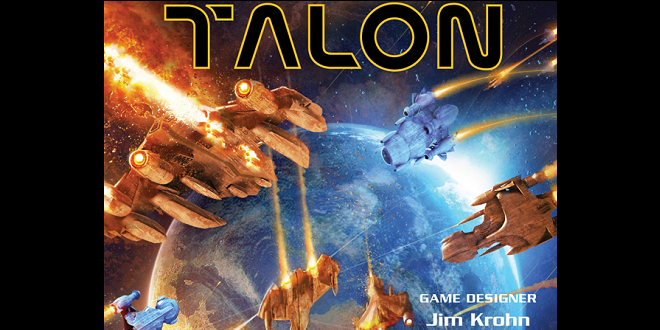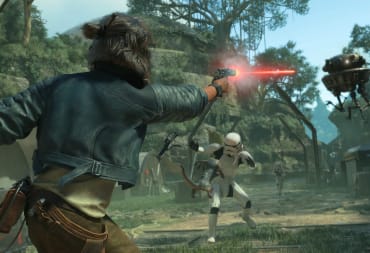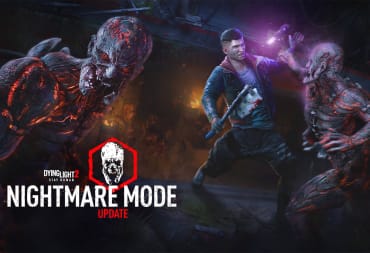When I was growing up, my dad and one of my brothers used to love all things Star Trek. I wasn't that big of a fan. While the away teams were beaming down to planets, and the space-drama was unfolding, I just wanted to see starship battles. I wanted to see the Enterprise blast apart Klingon Birds of Prey. On those few occasions when the ships did do battle they were fast, fierce, and devastating. The ships all had powerful weapons, and once a ship's shields were down, it didn't take much for the fight to turn fatal. Talon takes the excitement of deadly combat between capital ships and brings it to life with one of the cleanest, most solid mechanical foundations that I've seen in a tactical skirmish board game.
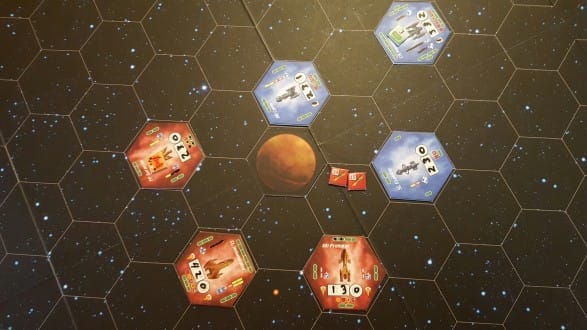
Talon's universe and storyline do a decent job of laying out the history of the two warring factions included in the box. On one side are the Terrans, the standard earthlings who discovered ways to boldly go where no man has gone before, and the Talon, the titular race of aliens whom the Terrans stumbled across out in the inky blackness of space. As these things tend to go, the first meeting between the two races started out with a bang, setting the stage for the glorious space battles that Talon's players take part in.
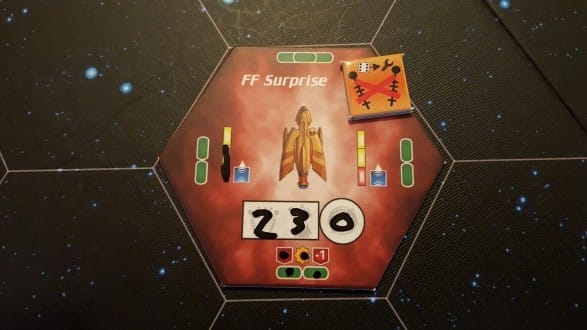
While the story sits squarely on the "generic" end of the spectrum, it presents itself in a familiar enough fashion, giving just enough of a wink and nod to a beloved franchise to feel familiar, while doing enough on its own to feel fresh. One of the big benefits of existing inside of its own fiction is the freedom to explore and tweak things without having to fit inside the pre-constructed box of an already existing fictional universe. While it isn't Star Trek: The Capitol Ship Skirmish Battle Game, it could easily fit in that role with a slightly more familiar coat of paint.
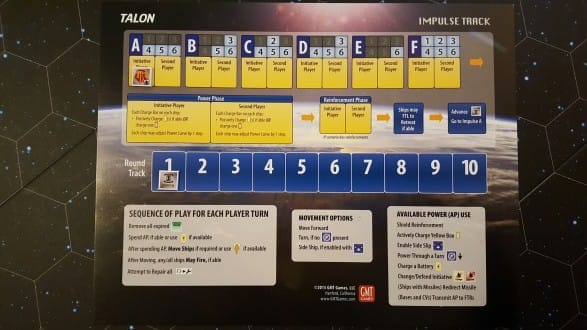
Even though the theme isn't as exciting as it could be, Talon's mechanics are absolutely rock solid. Each round of the game is played over a series of 6 Impulses. If your ship's Power or Movement values match a number listed in the current Impulse, you gain an Available Power, or move that ship one hex. Between each round is a Power phase, where players can adjust the Power Curve of their ships. Even though it looks, as one of my friends put it, "mathy," Talon is incredibly streamlined, allowing players to focus on getting their tactics, not the rules, right. Once you get a grasp on the way the Impulse phase works, it becomes second nature to plan out ship activations and movements.
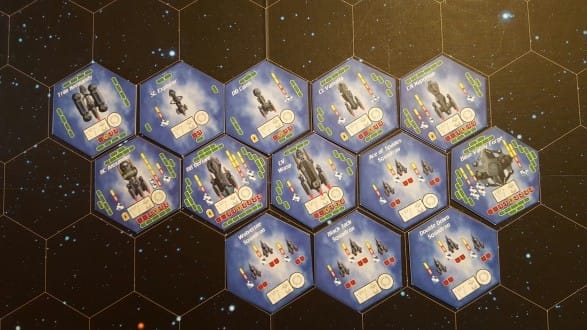
Each Impulse represents a few moments in time. If your ship has freed up more of its total power, you are going to be able to do more in those few moments, such as charge weapons faster, increase shield strength, or attempt to gain the initiative for the next Impulse. If your ship has moved more power to its engines and is traveling faster than other ships, it is going to move further. Since Talon is played on a hex grid, this means that your ship will move more often. If you misjudge your needs, you can re-allocate power during the Power Phase, if you haven't already paid the price for that miscalculation.
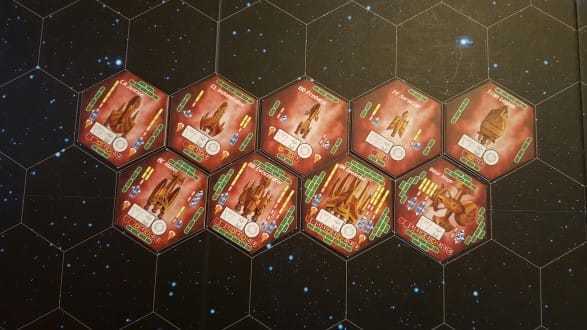
Finding the fine line between power and speed are crucial in Talon, especially because turn radii tend to increase with a ship's speed. It's not simply a matter of mashing on the throttle and flying around your opponents, because they will be able to take advantage of Initiative, increased shield power, faster charging weapons, etc. The inverse is also true. If you move too much power away from your engines, you will essentially become a sitting duck, unable to keep up with the other, faster moving ships.
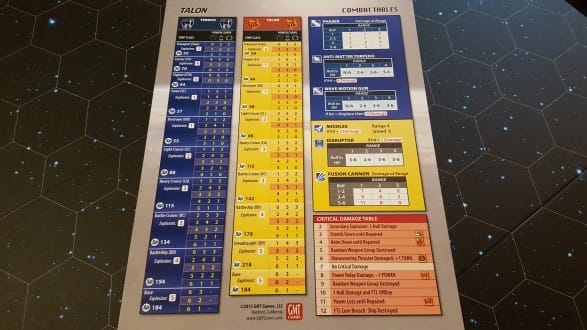
It makes a lot of sense to hover near the center, more balanced area of a ship's power curve, but savvy players can take advantage of the current game state by being aware of not just their immediate needs, but the needs they anticipate having over the next round. Smart shifts in speed and power can turn the tide of battle quickly in Talon, especially since weapons can be fired during any Impulse and tend to hit very hard.
The ships in Talon have various weapon systems that can be fired at a moment's notice. Like power and movement though, careful consideration needs to be made for when to fire. While the weapons can be unleashed in the blink of an eye, they take time to recharge, playing back into the Available Power/Speed balance. Additionally, the different weapons have different effective ranges and also different firing arcs. Each ship also has four separate shield banks, so where your shots will land is just as crucial as how hard those shots will hit. Yet again this plays back into the choices made when altering a ship's Power Curve. Firing shots as soon as they present themselves can often gain you very little if your opponents has managed to maneuver his ship in such a way that it only presents a shot at a full shield bank.
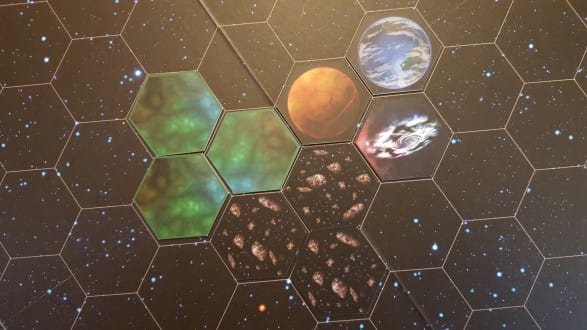
Line of sight mechanics in games, especially games that use facing rules like Talon does, can be fickle, fiddly, and annoying. Talon's system for line of sight is, like its other systems, simple. Range is determined by counting the hexes between the attacker and target, which is standard enough. The attacker must have the intended target within the arc of the firing weapon, of which there are four possibilities: front, port, starboard, and rear. Again, this isn't all that different. Where the brilliance in Talon's system lies is determining where the target is hit. Instead of having to draw straight lines from the attacker or some other standard method, the hits are taken based on which of the target's arcs the attacker is in. Because each ship token is the same size, and has the same four arcs, you can tell at a glance exactly where each shot will hit. I'd like to stress again how excellent this mechanic is. It not only allows the attacker to tell at a glance where their shots will hit, but also allows players to see exactly when and how they will be putting their ships into danger, or into position to attack, allowing them to make maneuvering decisions on the fly with no pause in gameplay to measure or draw lines. Brilliant.
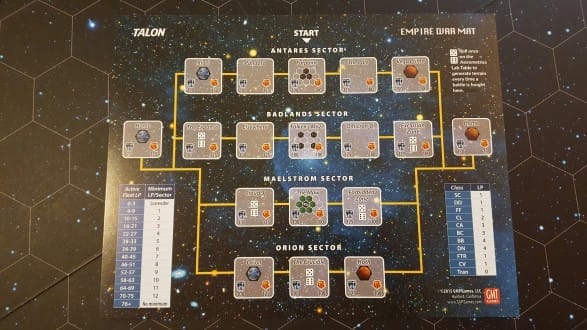
For players who want to extend their games of Talon past single skirmishes, there are 12 scenarios included that can easily be played as a campaign. For players wanting even more investment, Talon includes an Empire War mode that uses an Empire War map. This mode tasks players with using resources to construct and maintain their fleets, and then pits them against one another in numerous battles across multiple sectors. The front lines of the war move back and forth based on the outcomes of these battles, and the war is only won once one player has managed to win a battle over their opponent's home planet.
A note on player count: Talon is essentially a two player game, but more players can be added simply by having different players control ships on each side of the conflict, and with the sheer volume of ships in the box this is easily accomplished. Talon uses a rule for players who wish to play this way that enforces limited communication between teammates, allowing them to only speak a few words to one another at certain points during each round. This is a neat way to simulate the passage of (not much) time during each Impulse and round of Talon, thematically showing how quickly the fight would actually be unfolding if it were played out in real time.
A note on play time: A battle between two ships in Talon can play out in a matter of minutes, whereas larger ship battles can last many hours. It is essentially up to the players how long they want a game of Talon to last. If you want to play a quick, edge of your seat dogfight where you make decisions in the moment, you can. If you want to play a methodically planned out battle between entire fleets of warships you can. Talon's mechanics cater to players who enjoy playing fast and loose as well as players who are more keen on playing a slow, deliberate, and well-planned out game.
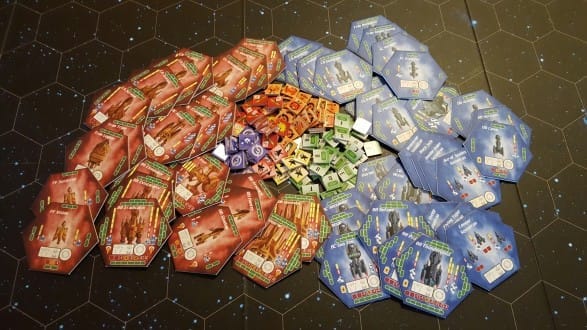
A note on “chrome”: The components and rulebooks in Talon are excellent. The ship tokens are intended to be marked on with dry erase markers, so they have a velvety, smooth finish on them that feels great, and the dry-erase ink wipes off easily. The rest of the components are also well-made, and GMT Games has put some "extras" in the box that really go above and beyond. The first "extra" is an additional half board, so players can play out large battles. The second "extra" is a pad of paper ship sheets, for those players who can't bring themselves to write directly on their ship tokens. That little bit of extra accommodation really makes it seem like GMT Games not only know their player base, and board gamers in general who like to take care of their components, but care about them and are willing to take proactive steps to show it.
The one downside to the components in Talon is that the box only includes one Combat Tables sheet. It's easy enough to make a second copy, but it was a strange choice to only include a single version of this sheet when they went out of their way to put other things in the box. The rulebook even lists 2 in the contents list, but, after looking into it, each box only contains one.
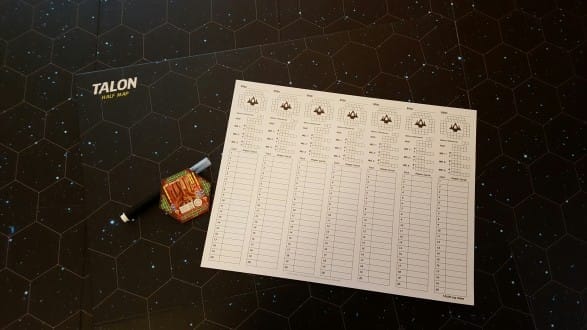
Talon also comes with rules that allows it to be used to resolve battles in GMT Games' other game, also by Jim Krohn, called Space Empires 4X. I haven't played Space Empires 4X, but based on how good Talon is, I want to. I can only imagine that it would take an inordinate amount of time to play through all of that game's battles using Talon, but it is a really neat idea, and a great option to have.
The bottom line:
Talon is an amazing game. The system that Jim Krohn has created fits the theme wonderfully and is so solid that it has huge growth potential, both in the Talon universe and beyond. The disparate parts of its streamlined mechanics mesh together nearly flawlessly while avoiding a lot of clunk that can drag other, similar games down. Don't confuse streamlined with simple though, there is so much depth, and so many strategic layers to the game, and it offers up so many different ways to play, that it's hard to imagine that anyone who has even a passing interest in tactical skirmish games, especially those set in space, would dislike Talon. Talon is a must buy.
Get this game if:
You enjoy tactical skirmish games.
You love the idea of capital space ship battles like those seen in Star Trek.
You want a game that provides incredible depth and complexity in the gameplay, not in overly complex rules.
Avoid this game if:
You don't like spaceships.
You prefer cooperative games.
The copy of Talon used for this review was provided by GMT Games.
Review Summary
Talon is top notch. It uses streamlined systems to lay the groundwork for incredible depth and immersion. If you enjoy tactical skirmish games, especially those set in space, Talon is a must have.
(Review Policy)Have a tip, or want to point out something we missed? Leave a Comment or e-mail us at tips@techraptor.net
